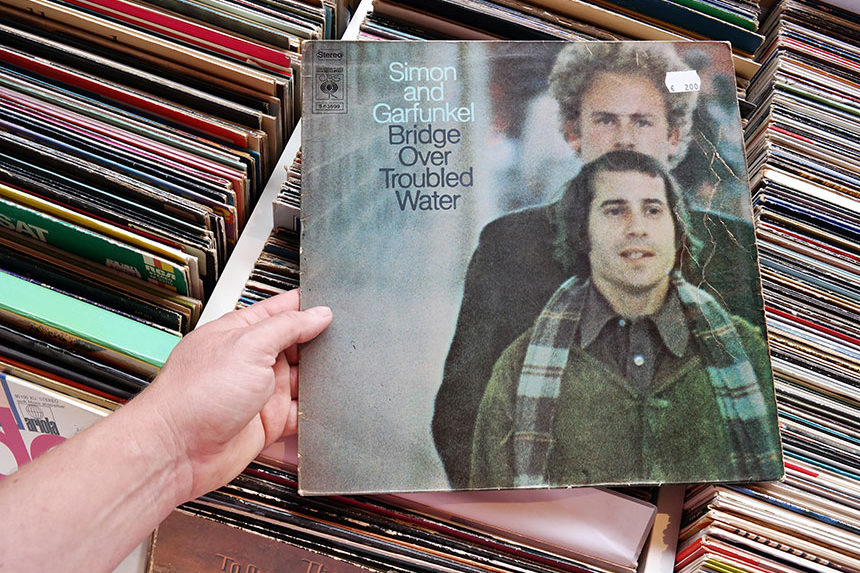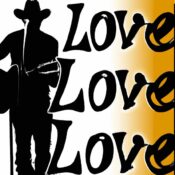One of the most celebrated and successful musical duos of all time, Simon and Garfunkel crafted a unique kind of harmony, even if their partnership wasn’t always harmonious. A staple of the 1960s who has experienced reignited interest in several decades since, the pair and their brand of folk-rock thrives even though it’s been 50 years since their last studio album together. And 50 years ago this week, what might be their signature song was in the middle of a six-week run at the top of the charts. Here’s how “Bridge over Troubled Water” is both their monument and their metaphor.
When Simon and Garfunkel were “Tom and Jerry.” (Uploaded to YouTube by Various Artists / Believe SAS)
Paul Simon and Art Garfunkel became friends as sixth graders in 1953, bonding over a mutual love of music. The boys sang in a doo-wop group together and performed as a duo at school events. When they were 15, they paid to record a song at a Manhattan studio; promoter Sid Prosen heard them and signed them to their first deal. Recording as Tom and Jerry, they had a minor hit (“Hey Schoolgirl”) that made #49 on the charts and got them booked on American Bandstand in 1957. They graduated in 1958 and went to different colleges, albeit both in New York City.
Though the two worked solo during their college years, they regrouped in 1963 after Simon’s graduation. Their sound moved into folk, and they played as Kane and Garr. Performing in Greenwich Village, the pair unveiled some new songs, including “The Sound of Silence.” On that fateful night, they were spotted by Tom Wilson, the influential producer who worked with Bob Dylan, Frank Zappa, the Velvet Underground, and more. Wilson got the duo signed to Columbia Records.
The Concert in Central Park performance of “The Sound of Silence.” (Uploaded to YouTube by Simon & Garfunkel)
Like the majority of young acts, their first album didn’t quite catch fire. Garfunkel went back to college, and Simon alternated between music work in England and school in the States, recording his first solo album across the pond. Fate had other things in mind for the duo, though; Boston DJ Dick Summer played “The Sound of Silence,” and suddenly stations along the East Coast picked it up. Wilson, pulling from the sound that he and Dylan had achieved on “Like a Rolling Stone,” remixed “Silence” by adding electric guitar and other elements. When the new version hit stores, it landed in the Hot 100. One million copies later, the song was #1 in January of 1966.
Feelin’ Groovy (Uploaded to YouTube by Simon & Garfunkel)
Over the next several years, Simon and Garfunkel became one of the biggest acts in music. Their hastily cobbled together Sounds of Silence album took advantage of the title song’s success and delivered two more songs (“Homeward Bound” and “I Am a Rock”) into the Top Ten. The two new albums, Parsley, Sage, Rosemary, & Thyme and Bookends were outsized hits; the pair’s fame was only magnified by their contributions to the soundtrack to the massively successful film, The Graduate. They were involved as both planners and performers in the storied Monterey Pop Festival, considered by many to be the instigating event in “The Summer of Love.” During this period, The Saturday Evening Post took a deep-dive look at some of the bigger acts in pop music, including Simon and Garfunkel.
Unfortunately, though they helped foster a new atmosphere of love and acceptance, creative and personal tension grew between the pair. Some was born out of Simon’s desire to do solo work, while other pieces came from Garfunkel’s ventures into film, appearing as he did in Catch-22 (and later, Carnal Knowledge, among others). Catch-22’s filming ran long in 1969, which caused more friction.
The pair performing “Bridge over Troubled Water” from The Concert in Central Park (Uploaded to YouTube by Simon & Garfunkel)
When the filming wrapped, Simon and Garfunkel went to work on what would be their final studio album, Bridge over Troubled Water. The 11 tracks were recorded in November of 1969, with the title track getting recorded halfway through the sessions. While there were some mixed critical responses upon its January 1970 release (most focused on a perception of over-production), the public had no such qualms. Bridge took the Grammy for Album of the Year and was the single best-selling album of 1970, 1971, and 1972; for several years, it was the best-selling album of all-time. 50 years ago this week, the title track was in the middle of a six-week run at #1 on the charts, and both “The Boxer” and “Cecilia” were Top Ten singles. “Bridge” is one of the most-covered songs to emerge in the 20th century, with artists like Aretha Franklin, Johnny Cash, and Elvis Presley all recording versions.
Despite the massive success of the album, the pair had already agreed to go their separate ways. Simon had an extremely successful career as a solo act, and Garfunkel worked consistently in both music and film. Over the years, they have reunited on several occasions for special concerts and short tours. The pair even appeared in a Saturday Night Live skit that centered on Simon remembering fans from specific concerts but being unable to recognize Garfunkel. While they have never recorded a studio album since Bridge, the live album The Concert in Central Park, capturing the 1981 live show that they played in front of 500,000 people in New York, sold two million copies. The pair toured extensively in 2003 and 2004, and as recently as 2009, but Garkfunkel’s vocal cord problems derailed the tour; though he recovered within a few years, relations between the two had grown icy again. Simon announced his retirement from touring in 2018, seemingly closing the door on that type of reunion occurring again.
Whether the duo reunites again or not, they’ve left behind a beloved body of work and a reputation for memorable songs with beautiful harmonies. Many critics consider both the single and the album Bridge over Troubled Water to be their defining work. It’s loomed large in popular consciousness for 50 years, and there’s no sign that its sound will ever resemble silence.
Featured image: defotoberg / Shutterstock.com
Become a Saturday Evening Post member and enjoy unlimited access. Subscribe now




Comments
Thanks, Bob; I appreciate it.
William, the ‘81-ish concert sounds like a wonderful experience. Still, I HAVE to wonder if Chris Fields has a point. Let me know, sir. We won’t think any less of you!
Troy, I really like this feature and appreciate the work you put into it. The historical research on the duo is wonderful, as are the links.
I’m sure Paul and Art have learned (over time) if you haven’t got something good to say, it’s best not to say anything!
With that in mind, good health and the right circumstances, I personally would love to see the duo do another U.S. tour! A combination of their collaborative hits and solo works agreed upon in advance. If it’s not meant to be, then it isn’t. Certainly nothing for the forseeable future with our nation in such dire circumstances.
@William Woods Are you sure that wasn’t just a hallucination?
I saw them at a concert in Boulder, Co – approx 1981ish? It was so much fun = held in the university stadium. At one end of the stadium – the sun was setting – the other – a double rainbow high over the the stage. The concert was fantastic and the evening was absolutely magic.